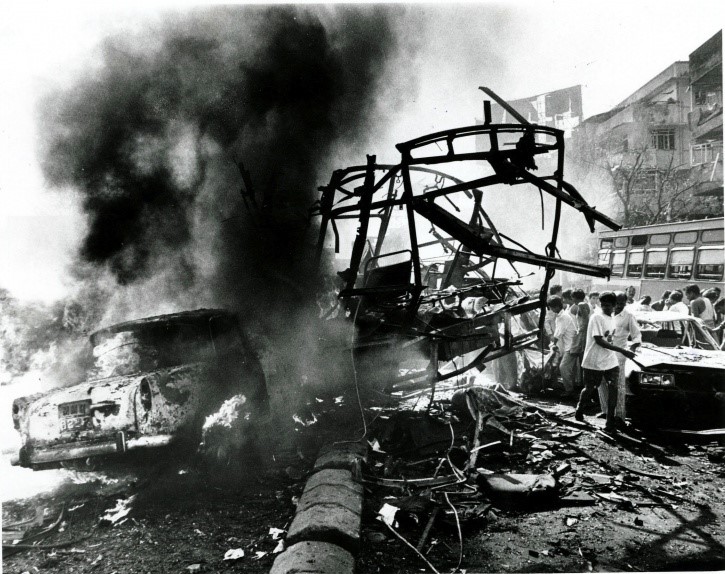EDITORS NOTE: This is the first article in a four-part series which explores the role of water in human conflict and politics. The series marks (though is not affiliated with) World Water Day 2016, a UN initiative to promote awareness of water issues. More information on World Water Day can be found here.
By: Paula Hanasz

Water wars; they seem inevitable in an age of non-traditional security threats and problems such as climate change requiring collective action. But water is rarely a single cause of conflict. Certainly, water can be a stress multiplier in a conflict, but violent conflict can also affect the equitable distribution of water – and thus exacerbate tensions. In other words, it’s complicated. Conflict is never straightforward, and neither is water governance.
Nonetheless, the fear of water wars persists. The logic is obvious to the point of a truism: water scarcity combined with rapidly increasing populations and the consistent growth in demand for food and energy will lead to competition between states over freshwater resources. This competition, the thinking goes, is likely to culminate in violent clashes over control of this precious, finite and irreplaceable resource.
Commentators such as Brahma Chellaney have built careers making this very argument. He argues that Asia may be on the brink of water wars fuelled by China’s accelerating consumption of water, energy and food, and its powerful upstream position vis-à-vis weaker, already volatile states on the Mekong and Brahmaputra Rivers (i.e., India and Bangladesh on the former, and Myanmar, Laos, Cambodia, Vietnam and Thailand on the latter).
Compelling though it is, the water wars thesis has been widely discredited by scholars. No war has ever been solely over water. Rather, hydropolitics – the geopolitics of water – is regarded by academics and policymakers to be complex. It is no longer possible to simply say that water causes conflict.
In recent years, water scholars, including many affiliated with the London Water Research Group based at King’s College, have shown that more often than not, there can be cooperation over a shared river and conflict over it at the same time. The Indus River is a prime example of this. The conflict between India and Pakistan following independence from the British Empire included disputes over the shared rivers of the Indus basin, and eventually resulted in the signing of the Indus Waters Treaty in 1960. Although the treaty still has its critics in both countries, it continued to function throughout the two wars between India and Pakistan.
Another important point is that water conflict is not always so bad, and water cooperation is not always what it seems. Disputes can force states to negotiate mutually agreeable outcomes, but at the same time, international treaties can cement an inequitable status quo. For example, India signed in 1996 an agreement with Bangladesh over the sharing of waters of the Ganges River, but this arrangement greatly favours India and continues to be a source of resentment within Bangladesh.
Just because water is not unequivocally a wellspring of conflict, that is no reason for complacency. Tensions over shared water resources are real and require our attention. The current conflict in Syria, for example, has been exacerbated by decades of weak governance in the water and agriculture sectors, and a lack of preparedness for severe drought. Water, in other words, is often one piece in a very complex puzzle of conflict.
The puzzle of water-related conflict does not necessarily reveal a picture of states contra states. Firstly, the notion of state’s priorities and approaches to water management as being homogenous is incorrect because subsets of national actors have different values and agendas. Secondly, most water-related violence happens at the sub-national level between tribes, sub-national governance units such as states or municipalities, rural and urban populations, water use sectors, etc.[1]
For example, the disputes between Indian states over shared rivers are arguably more heated and entrenched than water disputes that India has with neighbouring Nepal or Bangladesh. Similarly, disputes can arise between, for instance, industrial water users and agricultural water users, or between urban consumers and environmental conservationists. The Murray-Darling basin in Australia provides an illustration of tensions between water use sectors – farmers at odds with the city of Adelaide and the policymakers in Canberra wishing to reserve some river flow for environmental purposes and Aboriginal cultural rights.
An American water governance expert, Ken Conca, argues that while most conflicts over water occur at the local level – at the scale of a city, say, or the watershed –they are also often driven by powerful global forces. For example, Conca argues that, “[T]he growth of industrial fish farming is fuelled by changing consumer tastes in rich countries. Big hydroelectric projects in remote locations often power industrial processing facilities that plug into the global economy, while bypassing local economies and imposing a heavy burden on local communities”[2]
Another red herring in the puzzle of water conflicts is the issue of scarcity. Looking solely at factors such as the volume of water available per capita does not take into account spatial variability in water resources within countries and the technological or economic adaptation of nations at different levels of development.[3] Some states such as Israel are relatively arid but can still maximise their per capita allocation through technologies such as desalination plants; others, like India, have abundant water resources but lack apparatus and ability to distribute these resources efficiently or equitably.
In other words, water-related disputes do not arise out of a lack of water per se, but rather the misallocation or mismanagement of existing water resources. When the distribution of finite resources is perceived as unjust, that is when disputes begin.
More importantly, water is rarely, if ever, the single cause of conflict. It is, however, a stress multiplier. In the context of other socio-political disruptions, the lack of water or the inequitable distribution of water, can tip the often fragile socio-political stability off-kilter. Even the renowned scholar Aaron Wolf, who proposes the idea that water is largely a vector of cooperation, warns that “The lack of a clean freshwater supply clearly does lead to instability which, in turn, can create an environment more conducive to political or even military conflict.”[4] Wolf adds that “Water-related disputes can also engender civil disobedience, acts of sabotage, and violent protest.”[5]
Resentment about water allocation can combine with and exacerbate other existing tensions. The effects of climate change – another stress multiplier[6] – in conjunction with a population boom could, for example, lead to shortfalls in water supply in the Middle East and contribute to mounting discontent.[7] But environmental stresses alone are not enough to cause conflict.
Both Syria and California have faced severe drought in recent years. But only in Syria has the fabric of society almost completely disintegrated. Why? Mismanagement and lack of foresight have left the country ill prepared to cope with such a drought. In contrast, although the Californian drought is taking its toll too, the broader system of food production which is affected is more resilient to shocks: the USA is better equipped than Syria for dealing with natural disasters and the federal government structure is able to provide somewhat of an economic safety net. Resilience, then, is the factor that determines whether water stress can be contained or whether it will add to other stress multipliers and boil over into conflict.
The relationship between water and conflict flows in more than one direction. Water can be a stress multiplier in conflict, as we just saw, but violent conflict can also exacerbate the water situation. The effects of an existing or ongoing conflict can worsen the access to water for those who need it most, such as internally displaced persons. Water-dependent livelihoods, such as those in irrigated agriculture, could also be disrupted by conflicts that damage infrastructure or blocks access to water sources. This might set off a chain reaction across sectors, exacerbating the conflict further. After all, water security is inextricably linked with food security and, thus, human security.
Once conflict – no matter what its catalyst – encroaches on the availability of and access to environmental resources, it may become intractable. Grievances over control of natural resources may contribute to the onset of conflict, revenues from natural resources may finance conflict, and combatants often target or otherwise damage the environment.
In recent conflicts in Iraq, we have seen dams captured by militias; the threat of destroying the dam is used as a ‘stick’ against downstream population, while the promise of continuous water supply is a ‘carrot’. The ‘weaponisation’ of water and water infrastructure in this way is not a novel tactic; it has been employed by various groups in various parts of the world for centuries. But attacking water infrastructure in war time for military gain is no different from attacking or capturing other civil infrastructure and as such does not strictly fit into the understanding of water-related conflict.
Once violent conflict subsides, peace is often fragile: countries with past resource-related conflicts are, according to Environmental Peacebuilding, more likely to relapse, and to do so twice as quickly. Many parts of sub-Saharan Africa, for example, have been ravaged by conflicts over natural resource extraction, and unable to rebuild social and economic stability through subsequent droughts and famines.
As discussed above, the availability of and access to natural resources such as water can exacerbate or be exacerbated by conflict. The complexity of such conflicts has led to the development of a new discipline – environmental peacebuilding – which “integrates natural resource management in conflict prevention, mitigation, resolution, and recovery to build resilience in communities affected by conflict”
Environmental peacebuilding is a growing field.
In conclusion, wars between nation-states over freshwater resources are unlikely, but sub-state conflicts are not. Moreover, the cause and effect between conflict and water availability are not always clear or unidirectional. The same water resources can simultaneously be a source of conflict and an instrument for cooperation. In the coming decades, we will see more complex disputes develop, not only between groups of people, but also water-use sectors and urban versus rural populations. These resentments over water allocation may function as stress multipliers in other socio-political conflicts, which in turn could worsen the access to water resources for those most vulnerable. The conflicts we do see will certainly be more complex and requiring nuanced approaches, such as those that can be applied based on research within the emerging academic field of environmental peacebuilding.
Paula Hanasz is a PhD candidate at the Australian National University, Crawford School of Public Policy. Her thesis examines water security and conflict in the Ganges and Brahmaputra basins. She is interested in how international aid donors use Track II diplomacy to increase transboundary water cooperation. Paula is also an Associate with the Centre for International Water Law and Security at the London Centre of International Law Practice. @paulahanasz
Notes:
[1] Aaron Wolf et al, “Managing Water Conflict and Cooperation”, State of the World 2005 (The Worldwatch Institute, 2005), p. 87.
[2] Ken Conca, “The New Face of Water Conflict”, in Navigating Peace (No.3, November 2006), p. 3.
[3] Shira Yoffe et al, “Geography of international water conflict and cooperation: Data sets and applications” in Water Resources Research (Vol. 40, 2004), p. 2.
[4] Aaron Wolf, “Conflict and cooperation along international waterways”, in Water Policy (Vol. 1 #2, 1998), p. 9.
[5] Aaron Wolf et al, “Managing Water Conflict and Cooperation”, State of the World 2005 (The Worldwatch Institute, 2005), p. 88.
[6] National Research Council of the National Academies, Himalayan Glaciers: Climate Change, Water Resources, and Water Security (Washington D.C.: The National Academies Press, 2012), p. 89.
[7] Kurt M. Campbell et al, The Age of Consequences: The Foreign Policy and National Security Implications of Global Climate Change, (Center for Strategic and International Studies, Center for a New American Security, 2007), pp. 60-61.



